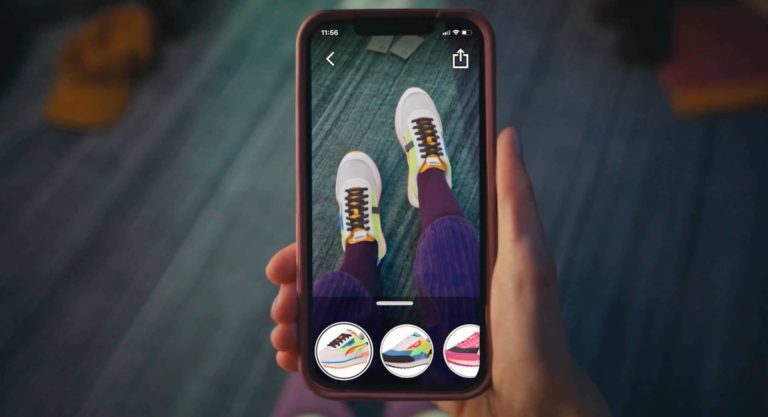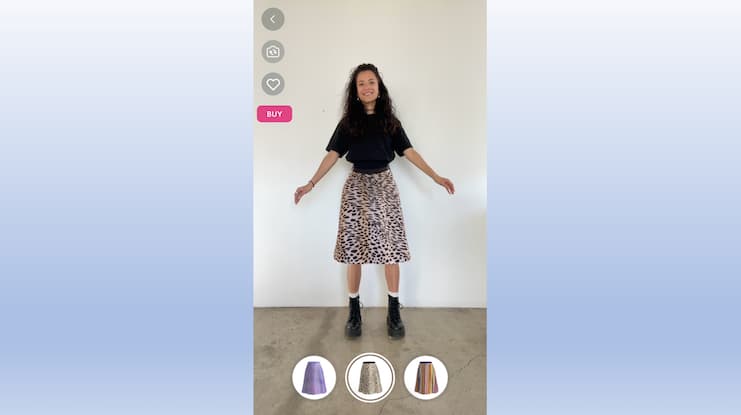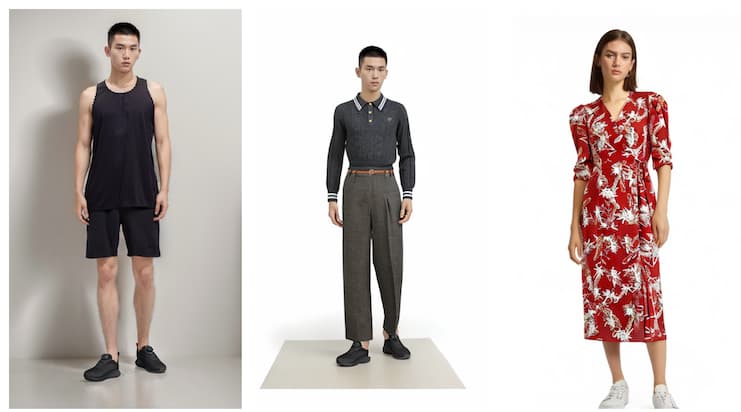
In the era of digital retail, AR-based virtual try-on (VTO) stands at the forefront of transforming the online shopping experience. As brands seek innovative solutions to reduce high return rates and enhance customer satisfaction, virtual try-on offers a promising avenue.
Here, we’ll explore the various technological form factors that currently exist for VTO, with a focus on the pros and cons of each, to help assess what currently might make the most sense for your business. Approaches include real-time 3D virtual try-on, generative image try-on, Avatar try-on, and AI survey-based try-on. We’ll discuss what each solution looks like in action, their respective technical requirements, advantages, limitations, and the potential for an integrated future solution.
1. Real-Time 3D Virtual Try-On
Technical Requirements
Requires high-fidelity 3D models of products, AR body-tracking software, a smartphone or computer with a camera, and an internet connection.
Pros
- Offers an immersive and interactive experience, allowing customers to see how garments and accessories look and fit from different angles and in motion, closely mimicking the in-store experience.
- Can be easily embedded to any e-commerce web page or platform.
- It is also easy for the user to capture realistic images and videos of themselves wearing the garment, and share them with friends via text or on their preferred social platform for a second opinion.
- Combined with AI technology, it’s possible to analyze the shape of a user’s face or body to recommend products that might best suit them from a fit perspective. When it comes to makeup, it’s possible to analyze the users’ skin tone and texture to recommend relevant products.
- On-device computation, which means that no personal data is sent to the server, allowing users not to worry about privacy concerns.
- The 3D try-on technology can be used not just to display clothes realistically, but also to create an immersive experience for users. The 3D engine can produce real-time effects that turn the try-on into an enjoyable experience that people will remember. This can create a buzz and generate more interest and traffic to the product’s e-commerce page. What’s more, if the same experience is used on the product page but with the effects disabled, 70-90% of the development cost can be saved.
- Realistic look. With the power of the 3D rendering pipeline, it’s feasible to reach 3D quality almost the same as the real product, making the try-on experience as immersive as possible.
- Opportunity to combine and try different parts of outfits together. The user is not limited to trying only one piece of outfit, it’s easy to try different tops + bottoms + accessories, that build to a vision of the possible look and how different combinations might be worn together. Or even to understand if that shirt goes well with a selected skirt.
- Stand apart from the competition with a unique technology, which represents the future of shopping.

Cons
- Cost of creating 3D models. For certain products like sunglasses and watches, there are generative AI solutions on the market that can help to automatically create 3D models out of 2D images.
- The need for devices with powerful processing capabilities can be a limiting factor.
2. Generative Image Try-On

Technical Requirements
Utilizes AI to superimpose clothing items onto a user’s uploaded photo; requires machine learning models and image processing technology.
Pros
- Provides a personalized try-on experience using the shopper’s photo, offering a quick and custom-fit preview.
- Low touch solution, without special preparation of the clothes assets.
- Can be more cost-effective, especially for small to medium-sized businesses. It reduces the need for physical photo shoots, models, and the logistics involved in arranging them.
- There are no device requirements, as the computation is happening in the cloud.
Cons
- Limited interaction and realism, as the try-on is based on a static image, which may not accurately reflect fit and drape. Lacks the interactive and dynamic nature of trying on clothes in real life or through AR.
- Photo processing is happening on the server side, which makes it necessary to store and analyze user’s data in the cloud outside of the device.
- The user can not examine how the garment looks or fits from different angles.
- Risk of creating unrealistic expectations if the renderings are overly idealized.
- Vulnerable to technical issues or glitches that can disrupt the user experience.
- When it comes to the new trend of 3D mirrors, it is difficult to make the experience enjoyable if it requires users to upload a photo and wait for results. Without a fun and interactive experience, it is challenging to create engaging and memorable try-on experiences.
3. Avatar Try-On

Technical Requirements
Involves creating a digital avatar based on user measurements, and requires user input and avatar modeling technology.
Pros
- Allows for a personalized try-on session without the need for real-time video or high-quality photos, offering privacy and convenience.
- Collects precise body measurements, providing valuable data for personalized marketing and product recommendations.
- In the future, this could be an interoperable asset that works across different fashion retailer sites to help shoppers understand true size fit.
Cons
- The generic nature of avatars may not accurately represent individual body types, affecting the perceived fit.
- Doesn’t feel quite as true to the in-person shopping experience, since the shopper sees a representation of themselves rather than their actual self.
- Requires users to input personal measurements, which might raise privacy issues or reluctance to share sensitive data.
4. Survey-Based Try-On

Technical Requirements
Relies on algorithms that recommend sizes based on user-provided measurements and preferences, and requires a comprehensive database and user interface.
Pros
- Simple and accessible, requiring minimal technical infrastructure and offering immediate sizing recommendations compared to more technologically advanced solutions like 3D avatars.
- Privacy-friendly, as it does not require camera access.
- Accessible to a wide range of users, requiring no special hardware or software beyond a basic web interface.
Cons
- Lacks the visual engagement of other methods.
- The process of filling out the survey might be boring for some users, which could lead to decreased use of the feature.
- It may not account for nuances in suitability and color preference beyond basic fit measurements.
- The accuracy of recommendations is highly dependent on the quality and honesty of the user-provided information.
- Might provide more generic results compared to highly personalized systems, leading to a less tailored experience.
So What’s the Right Solution?
The landscape of virtual try-on technology presents a diverse array of solutions, each with its own set of strengths and limitations. AR 3D Try-On, Generative Image-Based Try-On, 3D Avatar Try-On, and Survey-Based Try-On systems offer innovative approaches to enhancing the online shopping experience, addressing the perennial challenge of accurately visualizing and sizing products remotely.
Each technology caters to different business needs and customer preferences. The choice among these solutions should be guided by a balance of factors, including the level of personalization desired, the technological infrastructure in place, the target audience, and the specific goals of the retail experience.
As the retail landscape continues to evolve, these virtual try-on technologies will undoubtedly play a pivotal role in shaping the future of shopping, offering customers a more engaging, personalized, and satisfactory online shopping experience while providing retailers with valuable insights and tools to meet the ever-changing demands of the market.
Now, let’s imagine the future in the next five years where we have all the resources to build anything without limitations. Would you consider a real-time 3D try-on or a generative one or surveys if all of them have their best quality?
Users would probably prefer the most engaging option with the closest quality to the real clothes.
 Vladislav Bondarenko is lead AR Engineer at Geenee AR
Vladislav Bondarenko is lead AR Engineer at Geenee AR






